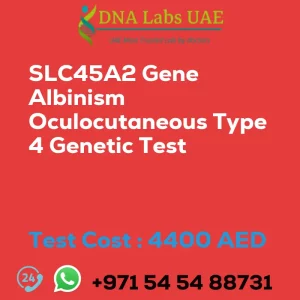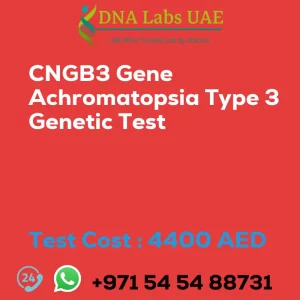CACNA1F Gene Cone-rod dystrophy X-linked type 3 Genetic Test
Introduction
The CACNA1F gene is associated with cone-rod dystrophy, X-linked type 3. This rare genetic disorder affects the retina, the part of the eye responsible for detecting light and sending visual information to the brain. Cone-rod dystrophy causes progressive vision loss, starting with the cones responsible for color vision and visual acuity, and later affecting the rods responsible for low-light vision and peripheral vision.
Test Details
The CACNA1F Gene Cone-rod dystrophy X-linked type 3 Genetic Test is a next-generation sequencing (NGS) test that analyzes the DNA sequence of the CACNA1F gene to identify any mutations or variants associated with cone-rod dystrophy. This test can help diagnose the condition and provide information about the genetic risk for other family members.
Test Components
- Price: 4400.0 AED
- Sample Condition: Blood or Extracted DNA or One drop Blood on FTA Card
- Report Delivery: 3 to 4 Weeks
- Method: NGS Technology
- Test Type: Ophthalmology Disorders
- Doctor: Ophthalmologist
- Test Department: Genetics
Pre Test Information
Before undergoing the CACNA1F Gene Cone-rod dystrophy X-linked type 3 Genetic Test, it is recommended to provide the clinical history of the patient and undergo a genetic counseling session to draw a pedigree chart of family members affected with the condition.
Test Process
The test requires a small blood or saliva sample. The NGS technology is used to analyze the DNA sequence of the CACNA1F gene. Results are typically available within a few weeks.
Genetic Counseling
Genetic counseling is recommended both before and after the test. This helps patients and their families understand the implications of the test results and make informed decisions about their healthcare.
Conclusion
The CACNA1F Gene Cone-rod dystrophy X-linked type 3 Genetic Test is a valuable tool for diagnosing rare genetic disorders like cone-rod dystrophy. With its ability to analyze multiple genes simultaneously, NGS testing provides highly accurate and sensitive results. The test helps diagnose the condition and provides information about the genetic risk for other family members, allowing for informed decision-making regarding healthcare.
| Test Name | CACNA1F Gene Cone-rod dystrophy X-linked type 3 Genetic Test |
|---|---|
| Components | |
| Price | 4400.0 AED |
| Sample Condition | Blood or Extracted DNA or One drop Blood on FTA Card |
| Report Delivery | 3 to 4 Weeks |
| Method | NGS Technology |
| Test type | Ophthalmology Disorders |
| Doctor | Ophthalmologist |
| Test Department: | Genetics |
| Pre Test Information | Clinical History of Patient who is going for CACNA1F Gene Cone-rod dystrophy, X-linked type 3 NGS Genetic DNA Test. A Genetic Counselling session to draw a pedigree chart of family members affected with CACNA1F Gene Cone-rod dystrophy, X-linked type 3 NGS Genetic DNA Test gene CACNA1F |
| Test Details |
The CACNA1F gene is associated with cone-rod dystrophy, X-linked type 3. This condition is a rare genetic disorder that affects the retina, the part of the eye that detects light and sends visual information to the brain. Cone-rod dystrophy causes progressive vision loss, starting with the cones, which are responsible for color vision and visual acuity, and later affecting the rods, which are responsible for low-light vision and peripheral vision. The NGS genetic test for CACNA1F gene mutations is a next-generation sequencing test that analyzes the DNA sequence of the CACNA1F gene to identify any mutations or variants that may be associated with cone-rod dystrophy. This test can help diagnose the condition and provide information about the genetic risk for other family members. NGS testing is a highly accurate and sensitive method for detecting genetic mutations, and it can analyze multiple genes simultaneously, making it a useful tool for diagnosing rare genetic disorders like cone-rod dystrophy. The test requires a small blood or saliva sample, and results are typically available within a few weeks. Genetic counseling is recommended before and after testing to help patients and their families understand the implications of the test results and make informed decisions about their healthcare. |








